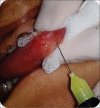The Efficacy of Low-Level Laser Therapy in Treating Oral Papilloma: A Case Reporting A Lingual Location
- PMID: 30294175
- PMCID: PMC6169293
- DOI: 10.4103/ccd.ccd_431_18
The Efficacy of Low-Level Laser Therapy in Treating Oral Papilloma: A Case Reporting A Lingual Location
Abstract
Oral papilloma is a benign proliferation of the stratified epithelium, which results in a papillary or verrucous exophytic mass, which can be induced by human papillomavirus. These oral mucosa lesions are most often asymptomatic and have small progression. Laser-assisted surgery is common nowadays with several advantages including successful hemostasis, devoid of sutures, wound sterilization and minimal postoperative pain, and edema. The aim of this report is to present the oral papilloma in a 40-year-old female patient and its treatment with soft-tissue laser. The lesion was excised with diode laser, and the healing was uneventful in a follow-up visit after 1 month. Oral papillomas can be found in young adult patient's oral cavity, and laser dentistry can be used by dental clinicians to treat these kinds of oral lesions and should be considered as an alternative to conventional surgery.
Keywords: Benign tumor; diode laser; low-level laser therapy; oral papilloma.
Conflict of interest statement
There are no conflicts of interest.
Figures









Similar articles
-
Laser treatment of an oral squamous papilloma in a pediatric patient: a case report.J Indian Soc Pedod Prev Dent. 2013 Oct-Dec;31(4):279-81. doi: 10.4103/0970-4388.121833. J Indian Soc Pedod Prev Dent. 2013. PMID: 24262405
-
Laser treatment of an oral papilloma in the pediatric dental office: a case report.Quintessence Int. 2007 Apr;38(4):307-12. Quintessence Int. 2007. PMID: 17432786
-
Squamous Papilloma on Hard Palate: Case Report and Literature Review.Int J Clin Pediatr Dent. 2018 May-Jun;11(3):244-246. doi: 10.5005/jp-journals-10005-1519. Epub 2018 Jun 1. Int J Clin Pediatr Dent. 2018. PMID: 30131649 Free PMC article.
-
Recurrent oral squamous papilloma in a pediatric patient: Case report and review of the literature.Niger J Clin Pract. 2018 Dec;21(12):1674-1677. doi: 10.4103/njcp.njcp_407_17. Niger J Clin Pract. 2018. PMID: 30560835 Review.
-
The application of diode laser in the treatment of oral soft tissues lesions. A literature review.J Clin Exp Dent. 2017 Jul 1;9(7):e925-e928. doi: 10.4317/jced.53795. eCollection 2017 Jul. J Clin Exp Dent. 2017. PMID: 28828162 Free PMC article. Review.
Cited by
-
Effectiveness of Photobiostimulation and Ablation With Diode Laser in Oral Squamous Papilloma: A Case Report.Case Rep Dent. 2025 Jun 22;2025:6293919. doi: 10.1155/crid/6293919. eCollection 2025. Case Rep Dent. 2025. PMID: 40590024 Free PMC article.
-
Human Papilloma Virus: Current Knowledge and Focus on Oral Health.Biomed Res Int. 2021 Feb 1;2021:6631757. doi: 10.1155/2021/6631757. eCollection 2021. Biomed Res Int. 2021. PMID: 33623784 Free PMC article. Review.
References
-
- Kerr AR, Phelan JA. Benign Lesions of the Oral Cavity. In: Greenberg MS, Glick, Ship, editors. Burket's Oral Medicine. Ontario, Canada: BC. Decker Inc.; 2007. pp. 132–7.
-
- Harries ML, Juman S, Bailey CM. Recurrent respiratory papillomatosis in the larynx: Re-emergence of clinical disease following surgery. Int J Pediatr Otorhinolaryngol. 1995;31:259–62. - PubMed

